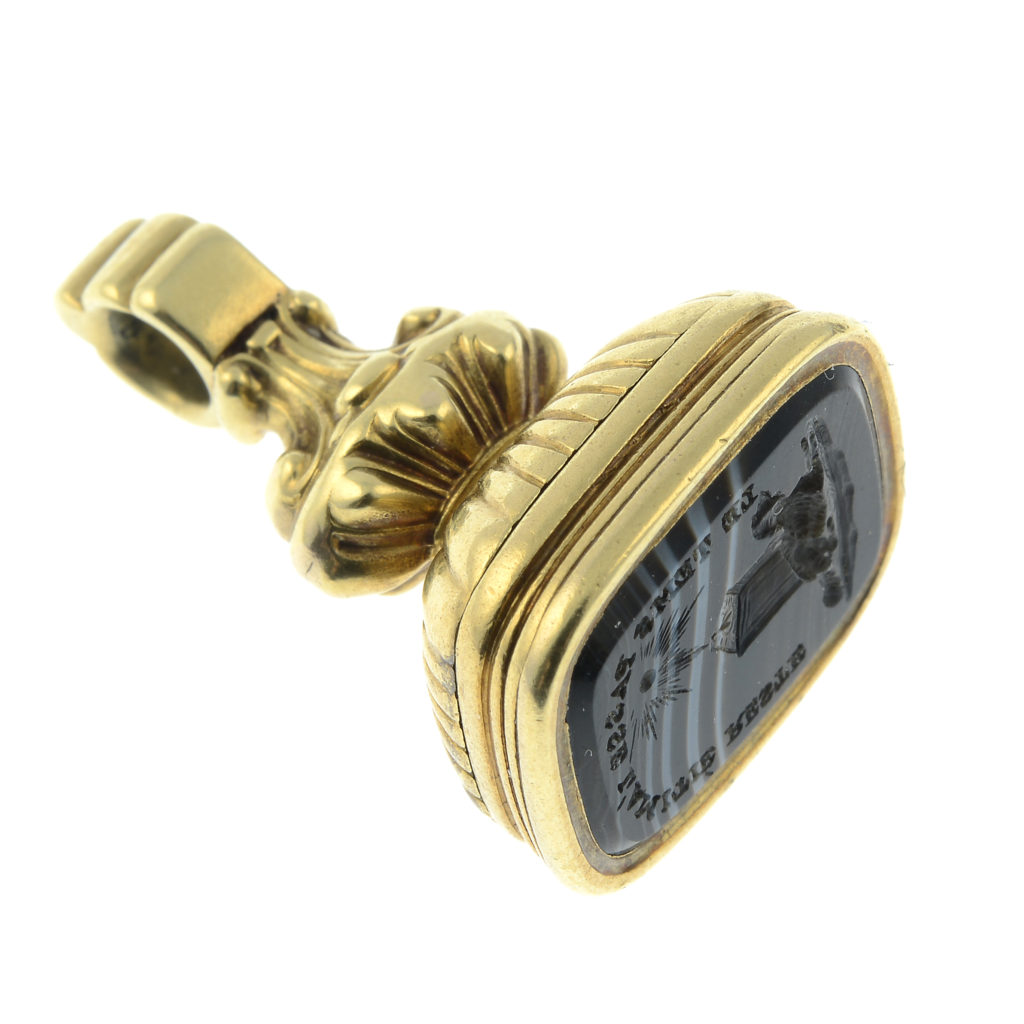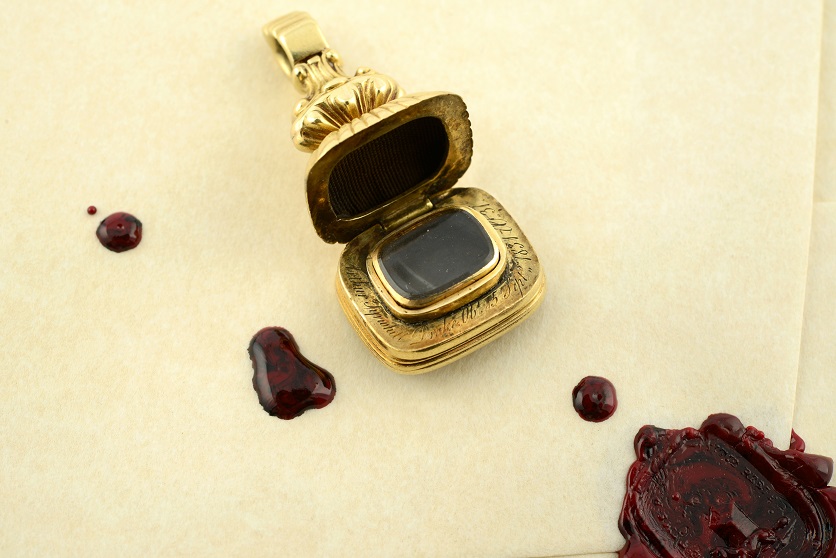Arthur Tyrwhitt Drake tragically died on his wedding day. His loved ones created a piece of jewellery to remember him and celebrate his life. Find out what a piece of jewellery can tell us about someone's life.
Arthur Tyrwhitt Drake's fob

The banded agate intaglio depicts a dog resting at the foot of a sundial. Its inscription ‘de tems passe d’amitié reste’ – roughly translates as ‘time passes, friendship endures’. This nineteenth-century fob expresses all the charm of companionship and loyalty. A further inscription to the inner compartment also links this fob to a family known for its love of political and community loyalty.
The banded agate intaglio fob was sold in the Fine Jewellery auction on October 6th 2022. Including fees, the piece sold for £624.
Arthur Tyrwhitt Drake
Arthur Tyrwhitt Drake (1800-1831), was one of the 14 children of Thomas Drake Tyrwhitt Drake and his wife Anne. Thomas and Anne were influential landowners and political representatives of Amersham, Buckinghamshire. Whilst his father and two of his brothers became the Members of Parliament (MPs) for Amersham, Arthur followed many other sons of landowners into the church. This was a respected and comparatively powerful profession in the eighteenth and nineteenth centuries. His relatively short life ended suddenly. He died at the age of 31, as recorded on this fob and the memorial plaque in the Drake Chapel. Tragically, Arthur suffered a fit of apoplexy at the end of his own wedding service. Before the more detailed medical understandings of the twentieth century, people used the term apoplexy to refer to a sudden death following a loss of consciousness. This was likely from an aneurysm, heart attack or stroke.

Memorials
Arthur’s memorial in the Drake Chapel in St. Mary the Virgin Churchyard Amersham depicts the sun shining through clouds onto a kneeling mourner. These motifs echo the sun and sundial of this memorial fob. The private burial vault was later presented to the church by a Tyrwhitt Drake descendant and consecrated as a chapel. In an ironic twist of fate, couples now enter the chapel to sign the marriage register at the end of their wedding service.
Whilst the fob likely once contained a lock of Arthur’s hair as a keepsake for a friend, a family member or his new wife, Arthur’s loyalty to friendship is only one aspect of the Tyrwhitt Drake sense of loyalty. In 1603, Joan Tothill married into the Drake family – relatives of the world circumnavigator Sir Francis Drake – and brought the Drake family to Buckinghamshire. Joan’s father owned multiple manors and instigated the purchase of the Borough of Amersham, which included the right to elect two Members of Parliament (MPs). Her husband, and later their sons (Arthur’s brothers), became the MPs for Amersham, and the roles passed down to various descendants of the male line.
Tyrwhitt Drake Family
Across England, these ‘rotten boroughs’ received increasing criticism through the eighteenth century for the coercive nature of their elections. As parodied in the third series of the classic BBC comedy Blackadder, rotten boroughs were considered to be under the control of one person or family that continued to capitalise on changes to the spread of towns, in particular where the urban centre had shifted over decades to leave areas with relatively small electorates but the same number of MPs. The abandoned and ruined medieval Wiltshire town of Old Sarum, for instance, still returned two MPs in the early nineteenth century, despite only having sheep as residents; whilst Blackadder’s fictional Dunny-on-the-Wold elected the bumbling Baldrick with a single vote from Blackadder.
For the Tyrwhitt Drakes of Amersham, their ownership of local inns and properties ensured a loyal electorate amongst their tenants and the wider community, especially as voting was conducted in person through a simple show of hands. No one dared to publicly show their dissent if, unusually, there was a rival candidate.
Arthur’s elder brother Thomas Tyrwhitt Drake was the final MP for Amersham. As a rare attendee of Parliament, he embodied the concerns of the critics. He voted only three times between 1812 and 1820 and likely against his constituents’ views. He did, however, come out to vote against the electoral reform bill. In 1832, the bill passed to become the Great Reform Act. The act dissolved 56 rotten boroughs, including his Borough of Amersham. Yet, even without their political title, the Tyrwhitt Drakes undoubtedly still benefited from local loyalty. In turn, they gave back to their community through municipal patronage and the establishment and maintenance of almshouses.
Whatever the form of loyalty Arthur’s fob was originally intended to represent, today it is a reminder of both a powerful family and of Arthur, who passed away at a pivotal time in his own life and his family’s history.













